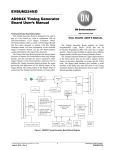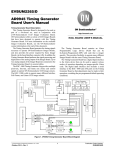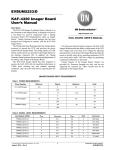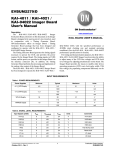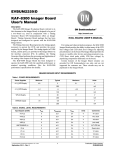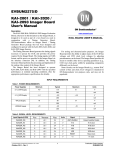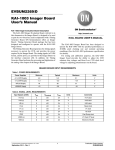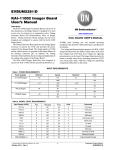Download EVBUM2252 - ADS-93X Timing Generator Board User's Manual
Transcript
EVBUM2252/D ADS-93X Timing Generator Board User's Manual Timing Generator Board Description http://onsemi.com This Timing Generator Board is designed to be part of a two−board set, used in conjunction with an ON Semiconductor CCD Imager Evaluation Board. ON Semiconductor offers a variety of CCD Imager Boards that have been designed to operate with this Timing Generator Board. For more information on the available Imager Evaluation Boards, see the ON Semiconductor contact information at the end of this document. The Timing Generator Board generates the timing signals necessary to operate Truesense Imaging Imager Boards, and also provides the power required by these Imager Boards via the board interface connector (J4). In addition, the Timing Generator Board performs the signal processing and digitization of the analog output from the Imager Board. The analog output of the Imager Board is connected to the Timing Generator Board via coaxial cable. EVAL BOARD USER’S MANUAL The Timing Generator Board contains an Altera Programmable Logic Device (PLD) that can be In−System−Programmed (ISP) with code that is imager specific. This provides flexibility to operate many different Imager Boards with the same Timing Generator Board. The Timing Generator Board has a digital Input interface to the Altera device that can be used to support various modes of operation depending on imager specific Altera code. SMB +12V REGULATOR LINE RECIEVER OP AMP CDS CLAMP OP AMP LPF OP AMP ADS-93x 16 BIT A/D 16 bits LVDS DRIVERS -12V REGULATOR SAMPLE FRAME GRABBER TIMING BOARD INTERFACE CONNECTOR CLAMP LVDS DRIVERS TIMING GENERATOR ALTERA 7000S ISP PLD DIGITAL INPUT BUFFERS DIO INPUT CONN VIN 100 PIN SCSI OUTPUT CONN CCD VIDEO PROCESSING CHAIN JUMPERS POWER CONNECTOR BOARD RESET BUTTON MASTER CLOCK UNIT INT CLOCK INT SYNC JTAG ISP HEADER Figure 1. Generator Board Block Diagram © Semiconductor Components Industries, LLC, 2014 August, 2014 − Rev. 2 1 Publication Order Number: EVBUM2252/D EVBUM2252/D TIMING GENERATOR BOARD INPUT REQUIREMENTS Table 1. POWER SUPPLY INPUT REQUIREMENTS Power Supplies Minimum +5 V Supply 4.9 Typical Maximum 5 5.1 Units V 500 −5 V Supply −5.1 mA −5 −4.9 V 150 VPLUS Supply 18 mA 20 24 V 25 VMINUS Supply −21 mA −20 −18 V 15 mA TIMING GENERATOR BOARD ARCHITECTURE OVERVIEW For best noise performance, linear power supplies should be used to provide power to the boards. The following sections describe the functional blocks of the Timing Generator Board. See Figure 1 for an overall block diagram of the Timing Generator Board. Voltage Regulators The operational amplifiers in the CCD video processing chain require ±12 V power supplies. These power supply voltages are regulated down from the VPLUS and VMINUS supplies input to the Timing Generator Board. Power Connector This connector provides the necessary power supply inputs to the Timing Generator Board. The connector also provides the power needed by the CCD Imager Boards. The Timing Generator Board simply routes these power supplies from the power connector to the board interface connector. Table 1 shows the power supply requirements for the timing generator board. This is not the total power requirement since this board is always used in conjunction with an image sensor board. The current requirements for the image sensor board are contained in its manual, and need to be added to the values listed in Table 1 to arrive at the total system power requirement. The “VPLUS Supply” voltage value can vary from 20 to 24 volts depending on the specific imager board. Consult the image sensor board manual for the required value. Power−On Clear / Board Reset The Altera Programmable Logic Device (PLD) resets and initializes the board on power-up, or when the BOARD RESET button in pressed. The default configuration is defined separately for each particular CCD Image Sensor, and is detailed in the associated Altera Code Timing Specification. Master Clock The master clock is used to generate the pixel rate clocks. The pixel rate timing signals operate at a frequency that is divided down from the master clock frequency. The exact pixel rate frequency is Altera code dependent, but is typically equal to 1/16 the frequency of the master clock. Power Supply Filtering Power supplied to the board is de−coupled and filtered with ferrite beads and capacitors in order to suppress noise. Table 2. TIMING BOARD CLOCK RATES Timing Board PN Master Clock Pixel Clock (Max) 3E8290 48 MHz 3 MHz Unit Integration Clock controlled by the Timing Generator Board and will be a multiple of this unit integration time. The actual integration time is dependent on how the integration control lines on the digital input connector are configured, as well as on how the Altera PLD is programmed. The unit integration clock is used as a means for varying the integration time. The clock circuit consists of a 555 timer configured to oscillate at a frequency of 100 Hz. The output of this circuit, the INTEGRATE_CLK, has a 10 ms period, which is used by the Altera PLD as the unit integration time. When the Timing Generator Board is configured to operate in the internal integration mode, the integration time is http://onsemi.com 2 EVBUM2252/D Integration Sync Output Connector Timing Generator PLD This output provides a signal that is high during the integration time period. This signal can be used to synchronize an external shutter or LED light source with the integration time period. The Programmable Logic Device (PLD) is an Altera 7000S series part. This device is In System Programmable (ISP) via a 10-pin JTAG header located on the board. In this way, the Altera device is programmed with imager specific code to operate the Imager Board to which the Timing Generator Board will be connected. The Timing Generator PLD controls the overall flow of the evaluation board operation. The PLD outputs include the CCD clocks signals, analog processing timing signals, and Frame Grabber synchronization signals. Digital Input Connector (Remote Digital Input Control) The digital input connector can be used to input control signals to the evaluation board. These control signals can be used to adjust the operating mode of the evaluation board. The functions of the digital inputs depend on what code the Altera device is programmed with. This is an optional feature. No external digital inputs are required for board operation. The digital input control lines to the board are buffered. The input pins to the buffer IC’s are weakly held low by pull down resistors to GND. Therefore, with no digital inputs, the default level of the Timing Generator Board control lines is all zeros. A three wire serial interface is also provided on the input connector. This interface consists of three lines, a serial clock, serial data, and a serial load signal. The serial interface is provided as an alternate way to adjust the operating condition of the Timing Generator Board if the Altera device is programmed with code to support this feature. LVDS Drivers Timing signals are sent to the Imager Board via the board interface connector using Low Voltage Differential Signaling (LVDS) drivers. LVDS combines high-speed connectivity with low noise and low power. Board Interface Connector This 80-pin connector provides both the timing signals and the necessary power to the CCD Imager Boards from the Timing Generator Board. CCD Video Processing Chain The CCD video signal from the Imager Board is input to the Timing Generator Board via the SMB coaxial connector. The coaxial cable is terminated with a resistor and is then buffered by a receiver op-amp with a gain of 1.25. Next the video signal is clamped to ground, effectively performing the first half of the correlated double sampling (CDS) function. Finally the video signal is passed through a low pass filter before being input to the 16-bit A/D converter. The A/D sample signal completes the CDS function and converts the signal to digital information. Jumpers There are four jumpers on the board that can be used to adjust the operating mode of the Timing Generator Board. The functions of the jumpers depend on how the Altera device is programmed, and is detailed in the associated Altera Code Timing Specification. JTAG Header ADS−93X 16−Bit A/D Convertor This 10-pin header provides the user with the ability to reprogram the Altera PLD in place via Altera’s BYTEBLASTER programming hardware. The Timing Generator Board supports the 16 bit ADS-93X family of convertors offered by Datel Inc. There are several variants in the ADS-93X family. The Timing Generator Board is populated differently depending on which convertor is being used. Table 3. TIMING BOARD CONFIGURATION OPTIONS Timing Board PN Datel A/D PN Sampling Rate Bit Depth Channels 3E8290 ADS−933MC 3 MSPS 16 1 Output Connector differential format. The connector also provides the three necessary PCI-1424 frame grabber synchronization signals in LVDS differential format. The output connector interfaces directly to the National Instruments PCI-1424 framegrabber. The output connector provides a single channel of 16 bit output data in LVDS http://onsemi.com 3 EVBUM2252/D CONNECTOR ASSIGNMENTS AND PINOUTS SMB Connector J5 J5 allows connection of the VOUT_CCD video signal from the CCD Imager Boards. Table 4. DIGITAL INPUT CONNECTOR J4 Pin Assignment Function Pin Assignment 1 SDATA SERIAL PORT 2 GND 3 SCLOCK SERIAL PORT 4 GND 5 SLOAD SERIAL PORT 6 GND 7 DIO15 Altera Code Dependent 8 GND 9 DIO14 Altera Code Dependent 10 GND 11 DIO13 Altera Code Dependent 12 GND 13 DIO12 Altera Code Dependent 14 GND 15 DIO11 Altera Code Dependent 16 GND 17 DIO10 Altera Code Dependent 18 GND 19 DIO9 Altera Code Dependent 20 GND 21 DIO8 Altera Code Dependent 22 GND 23 DIO7 Altera Code Dependent 24 GND 25 DIO6 Altera Code Dependent 26 GND 27 DIO5 Altera Code Dependent 28 GND 29 DIO4 Altera Code Dependent 30 GND 31 DIO3 Altera Code Dependent 32 GND 33 DIO2 Altera Code Dependent 34 GND 35 DIO1 Altera Code Dependent 36 GND 37 DIO0 Altera Code Dependent 38 GND 39 NO CONNECT N/A 40 GND Table 5. BOARD INTERFACE CONNECTOR J3 Pin Assignment Pin 1 N.C. 2 N.C. 3 AGND 4 AGND 5 TIMING_OUT11+ 6 TIMING_OUT11− 7 AGND 8 AGND 9 TIMING_OUT10+ 10 TIMING_OUT10− 11 AGND 12 AGND 13 TIMING_OUT9+ 14 TIMING_OUT9− 15 AGND 16 AGND 17 TIMING_OUT8+ 18 TIMING_OUT8− 19 AGND 20 AGND 21 TIMING_OUT7+ 22 TIMING_OUT7− 23 AGND 24 AGND 25 TIMING_OUT6+ 26 TIMING_OUT6− 27 AGND 28 AGND 29 TIMING_OUT5+ 30 TIMING_OUT5− http://onsemi.com 4 Assignment EVBUM2252/D Table 5. BOARD INTERFACE CONNECTOR J3 Pin Assignment Pin Assignment 31 AGND 32 AGND 33 TIMING_OUT4+ 34 TIMING_OUT4− 35 AGND 36 AGND 37 TIMING_OUT3+ 38 TIMING_OUT3− 39 AGND 40 AGND 41 TIMING_OUT2+ 42 TIMING_OUT2− 43 AGND 44 AGND 45 TIMING_OUT1+ 46 TIMING_OUT1− 47 N.C. 48 N.C. 49 AGND 50 AGND 51 N.C. 52 N.C. 53 VMINUS_MTR 54 VMINUS_MTR 55 N.C. 56 N.C. 57 AGND 58 AGND 59 TIMING_OUT0+ 60 TIMING_OUT0− 61 −5 V_MTR 62 −5 V_MTR 63 N.C. 64 N.C. 65 AGND 66 AGND 67 N.C. 68 N.C. 69 +5 V_MTR 70 +5 V_MTR 71 N.C. 72 N.C. 73 AGND 74 AGND 75 N.C. 76 N.C. 77 VPLUS_MTR 78 VPLUS_MTR 79 N.C. 80 N.C. Table 6. INTEGRATE SYNC CONNECTOR J1 Pin Assignment Function 1 INTEGRATE Signal is High during Integration Time Period 2 AGND Ground Table 7. POWER CONNECTOR J2 Pin Assignment 1 VMINUS 2 AGND 3 VPLUS 4 AGND 5 −5 V_MTR 6 AGND 7 +5 V_MTR 8 AGND http://onsemi.com 5 EVBUM2252/D Table 8. JUMPER SELECTS P[4..1] Jumper Pin Assignment Pin Assignment Pin Assignment Function P1 1 VCC 2 JMP0 3 AGND Altera Code Dependent P2 1 VCC 2 JMP1 3 AGND Altera Code Dependent P3 1 VCC 2 JMP2 3 AGND Altera Code Dependent P4 1 VCC 2 JMP3 3 AGND Altera Code Dependent Table 9. JTAG CONNECTOR P5 Pin Assignment 1 TCK 2 AGND 3 TDO 4 +5 V_MTR 5 TMS 6 N.C. 7 N.C. 8 N.C. 9 TDI 10 AGND Table 10. OUTPUT CONNECTOR J6 Pin Assignment Signal Level Pin Assignment Signal Level 1 AOUT0+ LVDS 2 AOUT0− LVDS 3 AOUT1+ LVDS 4 AOUT1− LVDS 5 AOUT2+ LVDS 6 AOUT2− LVDS 7 AOUT3+ LVDS 8 AOUT3− LVDS 9 AOUT4+ LVDS 10 AOUT4− LVDS 11 AOUT5+ LVDS 12 AOUT5− LVDS 13 AOUT6+ LVDS 14 AOUT6− LVDS 15 AOUT7+ LVDS 16 AOUT7− LVDS 17 AOUT8+ LVDS 18 AOUT8− LVDS 19 AOUT9+ LVDS 20 AOUT9− LVDS 21 AOUT10+ LVDS 22 AOUT10− LVDS 23 AOUT11+ LVDS 24 AOUT11− LVDS 25 AOUT12+ LVDS 26 AOUT12− LVDS 27 AOUT13+ LVDS 28 AOUT13− LVDS 29 AOUT14+ LVDS 30 AOUT14− LVDS 31 AOUT15+ LVDS 32 AOUT15− LVDS 33 N.C. 34 N.C. 35 N.C. 36 N.C. 37 N.C. 38 N.C. 39 N.C. 40 N.C. 41 FRAME+ 42 FRAME− 43 LINE+ 44 LINE− http://onsemi.com 6 EVBUM2252/D Table 10. OUTPUT CONNECTOR J6 Pin Assignment 45 Signal Level Pin Assignment N.C. 46 N.C. 47 N.C. 48 N.C. 49 PIXEL+ 50 PIXEL− 51 N.C. 52 N.C. 53 N.C. 54 N.C. 55 N.C. 56 N.C. 57 N.C. 58 N.C. 59 N.C. 60 N.C. 61 N.C. 62 N.C. 63 N.C. 64 N.C. 65 N.C. 66 N.C. 67 N.C. 68 N.C. 69 N.C. 70 N.C. 71 N.C. 72 N.C. 73 N.C. 74 N.C. 75 N.C. 76 N.C. 77 N.C. 78 N.C. 79 N.C. 80 N.C. 81 N.C. 82 N.C. 83 N.C. 84 N.C. 85 N.C. 86 N.C. 87 N.C. 88 N.C. 89 N.C. 90 N.C. 91 N.C. 92 N.C. 93 N.C. 94 N.C. 95 N.C. 96 N.C. 97 N.C. 98 N.C. 99 AGND 100 AGND Warnings and Advisories Signal Level Ordering Information ON Semiconductor is not responsible for customer damage to the Timing Board or Imager Board electronics. The customer assumes responsibility and care must be taken when probing, modifying, or integrating the Truesense Imaging Evaluation Board Kits. When programming the Timing Board, the Imager Board must be disconnected from the Timing Board before power is applied. If the Imager Board is connected to the Timing Board during the reprogramming of the Altera PLD, damage to the Imager Board will occur. Purchasers of a an Evaluation Board Kit may, at their discretion, make changes to the Timing Generator Board firmware. ON Semiconductor can only support firmware developed by, and supplied by, ON Semiconductor. Changes to the firmware are at the risk of the customer. Please address all inquiries and purchase orders to: Truesense Imaging, Inc. 1964 Lake Avenue Rochester, New York 14615 Phone: (585) 784−5500 E−mail: [email protected] ON Semiconductor reserves the right to change any information contained herein without notice. All information furnished by ON Semiconductor is believed to be accurate. http://onsemi.com 7 EVBUM2252/D ON Semiconductor and the are registered trademarks of Semiconductor Components Industries, LLC (SCILLC) or its subsidiaries in the United States and/or other countries. SCILLC owns the rights to a number of patents, trademarks, copyrights, trade secrets, and other intellectual property. A listing of SCILLC’s product/patent coverage may be accessed at www.onsemi.com/site/pdf/Patent−Marking.pdf. SCILLC reserves the right to make changes without further notice to any products herein. SCILLC makes no warranty, representation or guarantee regarding the suitability of its products for any particular purpose, nor does SCILLC assume any liability arising out of the application or use of any product or circuit, and specifically disclaims any and all liability, including without limitation special, consequential or incidental damages. “Typical” parameters which may be provided in SCILLC data sheets and/or specifications can and do vary in different applications and actual performance may vary over time. All operating parameters, including “Typicals” must be validated for each customer application by customer’s technical experts. SCILLC does not convey any license under its patent rights nor the rights of others. SCILLC products are not designed, intended, or authorized for use as components in systems intended for surgical implant into the body, or other applications intended to support or sustain life, or for any other application in which the failure of the SCILLC product could create a situation where personal injury or death may occur. Should Buyer purchase or use SCILLC products for any such unintended or unauthorized application, Buyer shall indemnify and hold SCILLC and its officers, employees, subsidiaries, affiliates, and distributors harmless against all claims, costs, damages, and expenses, and reasonable attorney fees arising out of, directly or indirectly, any claim of personal injury or death associated with such unintended or unauthorized use, even if such claim alleges that SCILLC was negligent regarding the design or manufacture of the part. SCILLC is an Equal Opportunity/Affirmative Action Employer. This literature is subject to all applicable copyright laws and is not for resale in any manner. PUBLICATION ORDERING INFORMATION LITERATURE FULFILLMENT: Literature Distribution Center for ON Semiconductor P.O. Box 5163, Denver, Colorado 80217 USA Phone: 303−675−2175 or 800−344−3860 Toll Free USA/Canada Fax: 303−675−2176 or 800−344−3867 Toll Free USA/Canada Email: [email protected] N. American Technical Support: 800−282−9855 Toll Free USA/Canada Europe, Middle East and Africa Technical Support: Phone: 421 33 790 2910 Japan Customer Focus Center Phone: 81−3−5817−1050 http://onsemi.com 8 ON Semiconductor Website: www.onsemi.com Order Literature: http://www.onsemi.com/orderlit For additional information, please contact your local Sales Representative EVBUM2252/D








